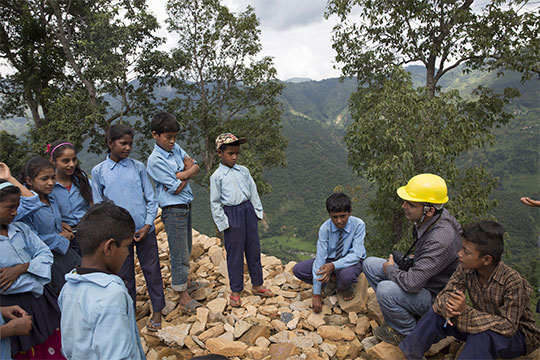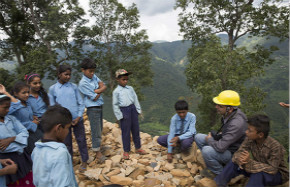Fighting the innovation antibodies: three years of exploration at UNDP Asia-Pacific
 |
|
The UNDP's Kamal Raj Sigdel talks to schoolchildren standing atop a pile of rubble that was once their school.[Photo provided to chinadaily.com.cn] |
Innovation is not always synonymous with the way most bureaucratic organizations work. So when UNDP in the Asia Pacific region decided to invest in this much hyped and scary concept skepticism reigned. We faced many "whys" but decided to proceed with cautious optimism.
Looking back now, it is astonishing how much we have gained. The investment has paid off, and the reward is the journey itself. Here is what we have achieved so far, and how we did it.
Evolving our engagement model
Often when we begin an innovation training session we ask colleagues to tell us what motivates them to be innovative. For us, the answer is obvious and no one captures it better than Jack Welch: “If the rate of change on the outside exceeds the rate of change on the inside, then the end is near.”
Based on feedback, we kicked off our first year with an innovation fund supported by the Danish government – a small resource backed by a “safe to fail” space. We engaged teams with the best ideas and mentored them through the rapid prototyping period. We celebrated both our successes and failures.
However, we realized that one challenge remained -- moving innovation from a program’s fringe to its core. We also realized we needed to build specialized skill sets to give staff new areas of expertise.
So in our third year we called for proposals. We conducted portfolio diagnostics at the country level and identified entry points for innovation in two specialized areas, innovative finance in Indonesia and big data in China. More recently, following the success of Sri Lanka’s first national innovation and foresight summit, we have been exploring investments in youth engagement and innovation through a Policy Innovation Lab.
What we gained
In short, a network of innovation champions, new solutions and a whole host of new and non-traditional partners and awards.
From partnering with Baidu to tackle e-waste in China to working with Mobimedia to fight corruption in Papua New Guinea, and from joining with DJI to use drones to collect CDRR data in the Maldives to creating our first virtual reality film following the quake in Nepal, we have tried to infuse innovation into everything we do.
We believe that our ability to provide innovative services is critical to our value in an increasingly middle-income region like Asia-Pacific.
Emerging principles
That is the short story of our three-year dive into innovation – but here are some of the insights that emerged in practice:
1.Knowing the unknown – you don’t know what you don’t know, so nurture intellectual curiosity. Let the geek in you gain the upper hand, spot the trends and get to know what you can work with and where the opportunity is. This doesn’t mean becoming a big data, alternative finance or design expert overnight, but rather being at one degree of proximity to the people who are, and collaboratively exploring applications for development.
2.Embracing the development mutants – traditional development is long gone. Today we see a whole host of new players, a new mutation of species in development that straddles both the public and private sectors. This is an incongruous mix. We could either deny it exists or figure out how best to work with it and learn from it. It’s this network of partners outside our usual suspects that has helped us innovate. Speaking to new people helps generate new ideas.
3.Innovation by leadership – where innovation is positioned on its structural ladder is indicative of how well an organization will thrive, and this is the distinguishing factor between offices that do well versus those that struggle. Yes, leadership matters, and exposure to innovation and not being risk averse are key to advancing the agenda.
4.Testing the hypothesis – we often design projects by what was, rather than what can be. Imagine drawing a line in the sand and saying no more of the usual. What else would or could you do? Designing project documents as testable hypotheses and developing prototypes helps manage risks upfront through multiple parallel experiments and demonstrations of proof of concept.
5.Exercising the innovation muscle – often people we meet talk about innovation as a state of mind, an inherent skill that one naturally possesses that helps you come up with good ideas. False! That’s probably the most over-rated myth. It’s much less about the ‘lightbulb’ moment than it is about a muscle that needs to be continually exercised – identify the bottlenecks, spot the trends, scan the horizon, fan your curiosity, find your partner, and talk to your users. Co-design, test, fail, and iterate.
6.Establishing your digital footprint – we often do great work but forget to talk about it. We also forget that most of us relate to individuals rather than an impersonal organization, so telling the story and putting yourself out there is key to gaining willing partners. After all, if you don’t sound interesting how can you attract interesting ideas or people?
What’s ahead?
As the cliché goes, we have miles to go before we sleep. Coming up, we have an iData studio that allows staff to get inspired by data innovations. We are also teaming up with AID:Tech on the use of blockchain technology applications for India.
We are advising the Islamic Development Bank on their innovation strategy and may also establish a lab in China where technology advancements can meet the test bed of development and proven solutions can be promoted at scale.
Finally, we recognize that to break the mould and create a new norm we need to focus not just on the front end but also the back office. So how might we re-imagine the future of a UNDP office where innovation is an intrinsic principle that embodies the organization as a whole rather than simply a part of it?
Stay tuned … and if you are interested in working with us, we are here, we are listening!
To know more about the authors’ program, please contact them at wei.zhang@undp.org
Co-authored by Haoliang Xu, UNDP Assistant Administrator and Director of the Regional Bureau for Asia and the Pacific, and Ramya Gopalan, UNDP Knowledge & Innovation Specialist.

























